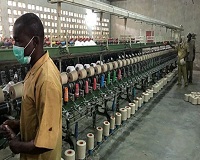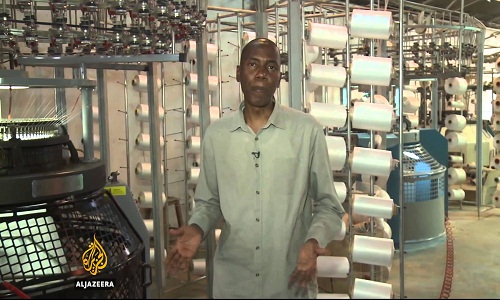FW
The Commonwealth Fashion Exchange has partnered with Google Arts & Culture to create an interactive platform to showcase fashion design talent from across The Commonwealth. The project in partnership with Swarovski, The Woolmark Company and MATCHESFASHION.COM showcases fashion talent from across 53 countries of the Commonwealth, where designers and artisans collaborate to create personalised women’s wear to illustrate the power and potential in partnerships and global co-design.
The Google Arts & Culture platform features over 1,000 artefacts and videos about these beautiful collaborations online, as well as stories from designers and artisans who participated in the unique project. The selected design labels include names such as Karen Walker representing New Zealand, Behno representing India, and Burberry and Stella McCartney representing the UK.
Bangladesh has received an order worth $1 billion to supply fan jerseys to the FIFA World Cup, which will be begin from July 14, 2018 in Russia. According to latest figures from Bangladesh Export Promotion Bureau, the country earned a net worth of $ 2.6 billion from the export of jerseys, pullovers and similar items made of cotton and man-made fibres. Around 100 factories were involved in the manufacturing of these jerseys.
This was also one of the main reasons behind a surge in export of knitwear items and apparel items in overall during the last month. In July-May period, knitwear exports rose 11.48 per cent to $13.94 billion and woven garments 8.15 per cent to $14.18 billion.
Mohammad Hatem, former VP, Exporters Association of Bangladesh, who is also a former Vice President of Bangladesh Knitwear Manufacturers and Exporters Association (BKMEA) and owns MB Knit Fashion exported 25,000 pieces of Spain’s fan jerseys, made of man-made fibre, at US $ 2.55 per item.
Global Fashion Agenda (GFA) has called on brands to join collaborative initiatives to help them get started on eliminating hazardous chemicals. GFA is a sustainability initiative run by the Danish Fashion Institute. It encourages brands to invest in research and new technologies to scale existing solutions up and to uncover new possibilities for current challenges.
Many fashion brands have not extended their sustainability efforts to include the processing stage where chemicals are used. Many are still in the beginning phase of eliminating hazardous chemicals. And they are searching for programs and tools that enable sustainably.
Since the processing stage within the value chain is a complex and fragmented one, many brands face difficulties in getting started. Hence, Global Fashion Agenda advises brands to join collaborative initiatives to profit from existing knowledge and experiences as taking action alone might be an overwhelming task. GFA collaborates with a group of strategic partners on setting a common agenda for industry efforts on sustainability in fashion.
Similarly the Greenpeace detox campaign aims at eliminating groups of chemicals of concern used in the fashion industry by 2020. Last year, Greenpeace warned about the industry's use of large quantities of polyester and its contribution to pollution of the oceans with microplastic fibers.
As a part of its commitment to science based targets, sportswear firm Asics has outlined a series of ambitious new sustainability targets and hailed its success in 2018 to decrease carbon footprint by 33 per cent. As per the company's sustainability report for fiscal 2017, they aim to cut carbon discharge from the supply chain by 55 per cent.
The company established its commitment to a circular economy by initiating partnerships to find new uses for used apparel. Through the bluesign system Asics has become the first Japanese brand to form a system partnership with bluesign. Asics collaborated with other brands, manufacturers, converters, and chemical suppliers on chemical management in the supply chain to improve sustainability in textile and footwear production.
Motoi Oyama, Chairman and CEO of Asics Corporation said that 2017 marked a major milestone for Asics with the launch of ‘I Move Me’, a global movement reimagining the 'sound mind in a sound body' philosophy which has guided the company for nearly 70 years. As the world becomes ever more aware of the impact of physical inactivity and mental illness, I Move Me reaffirms Asics decades-long commitment to supporting physical and emotional wellbeing. It also provides a fresh perspective on a broader sustainability approach.
The upcoming Apparel Textile Sourcing Canada (ATSC) show, scheduled from August 20-22, 2018 in Toronto, will showcase a line of futuristic clothing featuring seamlessly-integrated technology designed to both diagnose and treat health conditions. Some of these innovations include: stylish undergarments that act as an ECG monitor 24X7, alerting users to potential heart rhythm issues, as well as apparel that provides users with remote physiotherapy, meaning patients can receive professional rehabilitation therapy – including heat, electric stimulation and compression treatment – remotely from the comfort of their home.
The offerings will be among a wide range of features on display at ATSC, including 600 local and international exhibits, three full days of seminars, panels and sessions by industry, government and fashion leaders, business matchmaking services, and fashion runway events. The show will provide the thousands of expected attendees unprecedented networking and business opportunities with international suppliers on Canadian turf.
"Textile industry has gained pole position of polluting the environment, which is only after oil industry. A recent report by Yale Environment 360, testifies that in the US alone, people dispose off about 12.8 million ton of textiles annually — 80 pounds for each man, woman and child. India is one of the largest textile industries in the world today accounting for nearly 14 per cent of the total industrial production. In response to this, many homegrown brands are eyeing the sustainable expanse. Brands like Anamoly, Doodlage and Khara Kapaas are exploring new and revolutionary techniques and concepts which cater to and are benefiting the cause."
 Textile industry has gained pole position of polluting the environment, which is only after oil industry. A recent report by Yale Environment 360, testifies that in the US alone, people dispose off about 12.8 million ton of textiles annually — 80 pounds for each man, woman and child. India is one of the largest textile industries in the world today accounting for nearly 14 per cent of the total industrial production. In response to this, many homegrown brands are eyeing the sustainable expanse. Brands like Anamoly, Doodlage and Khara Kapaas are exploring new and revolutionary techniques and concepts which cater to and are benefiting the cause.
Textile industry has gained pole position of polluting the environment, which is only after oil industry. A recent report by Yale Environment 360, testifies that in the US alone, people dispose off about 12.8 million ton of textiles annually — 80 pounds for each man, woman and child. India is one of the largest textile industries in the world today accounting for nearly 14 per cent of the total industrial production. In response to this, many homegrown brands are eyeing the sustainable expanse. Brands like Anamoly, Doodlage and Khara Kapaas are exploring new and revolutionary techniques and concepts which cater to and are benefiting the cause.
Anomaly
Founded by Medha Khosla, who has 14 years of experience in technical design from New York, Anomaly is a versatile workwear brand, which seamlessly transitions from day to night by offering classic pieces created using natural and sustainable Indian textiles. The brand banks on limited production and wastage, made using only natural textiles with a strong emphasis on quality. It addresses the problem of overstocking by producing less and upcycling any leftover fabric into home textiles, which they sell under a different line. Leftover stock, if any, is donated on a yearly basis. Adopting a Lean production model, the brand operates from a single unit based in Shahpur Jat, which staffs 8 people who oversee everything from concept to finishing.
versatile workwear brand, which seamlessly transitions from day to night by offering classic pieces created using natural and sustainable Indian textiles. The brand banks on limited production and wastage, made using only natural textiles with a strong emphasis on quality. It addresses the problem of overstocking by producing less and upcycling any leftover fabric into home textiles, which they sell under a different line. Leftover stock, if any, is donated on a yearly basis. Adopting a Lean production model, the brand operates from a single unit based in Shahpur Jat, which staffs 8 people who oversee everything from concept to finishing.
The brand plans on venturing into unisex lines that push the boundaries of dressing forward by including a wider gamut of classic pieces that stand the test of time. On all-inclusive fashion, the brand supports equal representation, and plans to take into consideration petite and plus-size lines in the future.
Doodlage
Experts say, just between India, China and Bangladesh, there are about 1.20 billion sq. mt. of fabric that gets discarded every year. Finding ways to work with these fabrics instead of mass producing fresh ones, will massively contribute towards a more circular economy. Upcycling leftover scraps and recycling post-consumer waste, Doodlage works on the theory ‘one man’s trash is another man’s treasure’. After having gained recognition in womenswear, the brand expanded into menswear as well. It sources 90 per cent of its fabrics from major exporters, printers and dyers, who are rejecting enormous amount of post-cutting scrapes, defective fabrics, and yarns and then work with those fabrics to create its own collections.
Each garment is produced end-to-end by one particular person, so each piece is as distinct as the person who is wearing it. The brand now plans to expand in the kids’ wear and lifestyle products segment to ensure that the message of upcycling finds a permanent room in as many wardrobes as possible.
Khara Kapaas
Shilpi Yadav, Founder of Khara Kapaas, has spent a lot of time travelling around the country experiencing different cultures and traditions. This made her a specialist of local crafts and locally sourced materials. Using natural dyes, azo-free block printing processes and blends, the brand enjoys a faithful clientele both in India and abroad. Tapping demand for her work, she identified the gap in the market for sustainable pregnancy and maternity ranges and fill it in. After experimenting with three different lines, the designer is looking at expanding in the bags and shoes categories.
"Before the inception of the Special Presidential Committee on the Resuscitation of the Cotton, Textile and Garment Industry, Nigeria’s textile sector, was in a dismal state. Factories in Lagos, Zaria, Kaduna and Kano were performing below production capacities. Employees had been maintained only because either the employers did not want to lose them or their parents had been active players in the sector. The machines, not being used, were covered with dust. Some factories had stocks untouched for ages, while others faced an acute shortage."
 Before the inception of the Special Presidential Committee on the Resuscitation of the Cotton, Textile and Garment Industry, Nigeria’s textile sector, was in a dismal state. Factories in Lagos, Zaria, Kaduna and Kano were performing below production capacities. Employees had been maintained only because either the employers did not want to lose them or their parents had been active players in the sector. The machines, not being used, were covered with dust. Some factories had stocks untouched for ages, while others faced an acute shortage.
Before the inception of the Special Presidential Committee on the Resuscitation of the Cotton, Textile and Garment Industry, Nigeria’s textile sector, was in a dismal state. Factories in Lagos, Zaria, Kaduna and Kano were performing below production capacities. Employees had been maintained only because either the employers did not want to lose them or their parents had been active players in the sector. The machines, not being used, were covered with dust. Some factories had stocks untouched for ages, while others faced an acute shortage.
Attempts to resuscitate the textile industry had failed as it was saddled or burdened with legacy issues. Apart from infrastructure challenges, high gas prices, diesel and insufficient supply of low fuel pour oil; issues of distrust and insincerity across the line, low patronage, inadequate quantity and quality for supplies, smuggling of fabrics and availability of cheaper options, etc also plague the industry.
New revival strategies
To drive the sustainable implementation of the Cotton, Textile and Garment (CTG) policy, as well as President Muhammadu Buhari’s policy thrust and vision in the textile industry, the government in April 2016 inaugurated a special Implementation Committee involving critical stakeholders. The Committee is responsible for overall revamping of the sector besides attracting investments across the value chain i.e. cotton farming, cotton processing, textile manufacturing and garmenting.
vision in the textile industry, the government in April 2016 inaugurated a special Implementation Committee involving critical stakeholders. The Committee is responsible for overall revamping of the sector besides attracting investments across the value chain i.e. cotton farming, cotton processing, textile manufacturing and garmenting.
Accordingly, the committee devised strategies to garner support for locally made fabrics. These included ascertaining quality and source of raw materials, identification of possible linkages of producers and end-users of locally produced fabrics and the development of the garment sub-sector for increased productivity.
Key challenges faced by industry
As per the committee, some of the key challenges affecting the sector include: lack of cotton lint, smuggling and counterfeiting, inadequate infrastructure, access to power, and funding. The committee was able to access working capital to enable manufacturers acquire necessary raw materials and other essential inputs for production activities. It also secured loan re-financing and recommended 60 per cent of forex allocation from CBN. However, complete overhaul of the industry requires around N500 million to N1 trillion. These funds have been hampered by the high interest rates charged on loans by financial institutions. The committee recommended the government should approve loans granted to the textile industries by the Bank of Industry. BOI should be takenover by the Central Bank with a view to extending the repayment tenor. Also, the accumulated 10 per cent of tariff on imported textile materials, for the development of local manufacturing sector in Nigeria, should be made available to the sector players without much further delay.
The Committee, in its bid to resolve the issue of high gas pricing, has secured a presidential approval for the re-categorisation of textile manufacturers as strategic industrial sector as against earlier classification in the “commercial sector.” The major implication of the policy shift is the elimination of the many bottle necks in the supply of energy to the textile mills. Once implemented, gas supply to textile manufacturers will cost only $3 per standard cubic feet as against the old regime of $8.45.
Other impediments hindering speed in the actualisation of the President Muhammadu Buhari’s blueprint of action in the textile sector include: un-abating phenomena of counterfeiting and smuggled textile materials especially from China. The Nigeria Customs Service and other security agencies will have to beef up vigilance in their statutory duty of checking influx of banned textile materials into the country.
Techtextil North America and Texprocess Americas took place from May 22 to 24, 2018. The co-located events brought together latest innovators in technical textiles, nonwovens, textile machinery, sewn products, equipment, and technology.
Cooling fabrics, smart light technology, recycled fibers, 3D body scanning, and cloud connected smart machines were just some of the highlights. The events attracted 567 Techtextil North America and Texprocess Americas exhibitors representing 32 countries, attendance grew by four per cent over 2016 events. Techtextil North America and Texprocess Americas have become premier events where professionals from all industries visit to witness latest trends and technologies.
The co-located events were buzzing with visitors and speakers discussing new technology, game-changing research and cross-industry collaborations. Among the topics in focus were: smart textiles, wearables and the future of the technology that powers them proved to be top of mind for many attendees. In addition, how automation, robotics and connected machines are contributing to the industry‘s evolution made an evident impression on both visitors and exhibitors alike.
The spotlight was also on Industry 4.0 - communication between fabrics, the machine, the human, the CAD. The events showcased numerous new equipment, products etc updating visitors on what’s next for the textile industry.
Recent increase in cotton prices has become a cause of concern to the textile industry, the main consumer of cotton. Rates are likely to remain high next season due to China imports. Cotton stocks with small and medium-scale mills are likely to remain low affecting those who buy for daily needs. The mills that had bought cotton at the beginning of the season are likely to benefit now. These mills fear that he prices might go up further as the season ends, affecting the entire textile value chain.
Apart from price, the mills also faced quality issues in domestic cotton this year. Further, the industry fears that prices might remain high next season as well as China was importing cotton. According to textile mills, the higher cotton prices reflected on yarn prices. For, some yarn varieties, the prices had increased by 15 per cent
American fashion house Ralph Lauren aims to increase sales by a billion dollars by 2023. Marketing spend will go up by $100 million over the next five years. The last few years have been about cutting costs including closing 50 stores, eliminating more than 1,000 jobs and removing three lines of management.
The goal is to woo next generation consumers and increase gross margins by improving the core product (which makes up 60 per cent of overall revenue), amplifying under-penetrated categories (including women’s, outerwear and denim) and operating with discipline, which constitutes being more careful about discounts and promotions, more strategic when it comes to price, and cutting costs in creative-but-impactful ways.
One example of this is fabric platforming. At Ralph Lauren, different categories (i.e. home, kids, Polo, ready-to-wear) use different quality of fabrics. Instead of each sub-brand buying its own fabric, Ralph Lauren is buying higher quality fabrics, which brings down the cost and increases the quality of lower priced products.











